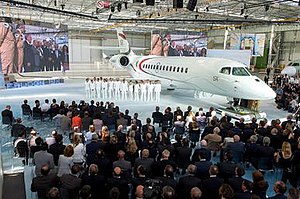Dassault Falcon 5X
| Falcon 5X | |
|---|---|

| |
| June 2, 2015 roll-out | |
| Role | Business jet |
| National origin | France |
| Manufacturer | Dassault Aviation |
| First flight | 2017 (scheduled) |
| Introduction | 2020 (scheduled) |
| Status | Under development[1] |
| Number built | 0 |
The Dassault Falcon 5X is a large, long-range business jet under development in France by Dassault Aviation.[2]
Its projected 5,200 nmi (9,630 km) range is not as high as that of the Falcon 7X, but the 5X has a larger fuselage diameter and greater cabin volume.[3] On 29 January 2016, Dassault Aviation confirmed a two-year delay and production freeze on the Falcon 5X because of ongoing problems with the Snecma Silvercrest engine. The first flight is scheduled to take place in 2017, with an entry into service in 2020.[1]
Design and development
Design work began in 2006 under the codename SMS for super-midsize, and was envisioned to compete with the Hawker 4000, the Bombardier Challenger 300 and the Gulfstream G200 or the Embraer Legacy 600 with a 3,400 nmi (6,297 km) range. Few details were publicized, except that the model was to be powered by two 10,000-pound-thrust Rolls-Royce RB282 engines.[4][5] In 2009, design choices have been reopened and the engine evaluation process was re-opened.[6]
The project was revamped after the 2008 recession when demand for super midsized and smaller aircraft decreased dramatically, while demand for the large-cabin, long-range models remained vigorous. It was unveiled at the National Business Aviation Association's annual convention in October 21, 2013.[4] The aircraft is now planned to be powered by two Snecma Silvercrests.[3] The cabin will also feature an unusual "zenith window" in the roof, allowing more light to enter the cabin.[2]
Specifications
Data from Flight International 2013[7]
General characteristics
- Crew: 3
- Capacity: 16
- Length: 25.2 m (82 ft 7 in)
- Wingspan: 25.9 m (85 ft 1 in)
- Height: 7.5 m (24 ft 6 in)
- Max takeoff weight: 31,570 kg (69,600 lb)
- Maximum landing weight: 29,980 kilograms (66,095 lb)
- Maximum zero fuel weight: 22,790 kilograms (50,243 lb)
- Powerplant: 2 × Snecma Silvercrest , 50.9 kN (11,450 lbf) thrust each
Performance
- Maximum speed: 956 km/h (594 mph, 516 kn) at cruising altitude
- Maximum speed: Mach 0.90
- Range: 9,600 km (6,000 mi, 5,200 nmi) with 8 passengers + 3 crew, NBAA IFR reserves, ISA, full fuel, mach 0.8
- Service ceiling: 16,000 m (51,000 ft)
- Balanced field length: 5,250ft (MTOW, SL, ISA)
- Approach speed (Vref): 105kts ias (Typical landing weight, SL)
See also
Aircraft of comparable role, configuration, and era
Related lists
References
- ^ a b "Dassault confirms two-year delay for 5X". flightglobal. 29 January 2016.
- ^ a b "Falcon 5X - Overview". Dassault Aviation.
- ^ a b "Dassault Reveals New Falcon 5X Business Jet at NBAA". AINonline. 22 October 2013.
- ^ a b Cite error: The named reference
AviationWeek2013was invoked but never defined (see the help page). - ^ "Few new details emerge on Dassault super-midsize jet". AINonline. 6 October 2008.
- ^ "Dassault rethinks SMS; questions engine choice". Aviation International News. 14 June 2009.
- ^ "falcon 5X special Report" (PDF). Flight International. 29 October 2013.
External links
- Manufacturer specifications
- Tim Hall (2013). "Falcon 5X cutaway" (PDF). Flight International.
